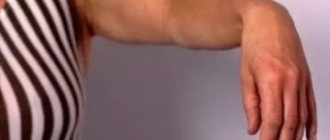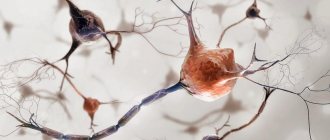Among a number of aphasic disorders, acoustic-mnestic disorders occupy a special place.
What acoustic-mnestic aphasia is, why and under what problems does this memory lesion occur in the body, what disorders it leads to, what are the features of diagnosis and correction will be discussed below.
What is the reason?
The appearance of the disorder is the result of damage to certain areas of the cerebral cortex. Pathology occurs in the temporal part of the dominant hemisphere , in its mid-posterior sections. These are the so-called Brodmann cytoarchitectonic areas 21 and 37. For most people, the left hemisphere is dominant.
Disruption of the functioning of these departments can occur due to deterioration of blood circulation in this place, inflammatory processes, and trauma.
As a result of the latter, the integrity of the brain structures is disrupted or compression occurs:
- Stroke .
The most common factor in this type of aphasia. An ischemic stroke leads to insufficient blood supply and oxygen starvation of the cerebral cortex. In a hemorrhagic stroke, blood leaking from damaged vessels compresses the brain tissue. - Traumatic brain injuries . The damage received during the injury itself is accompanied by swelling, which puts pressure on the brain structures. An inflammatory process may also begin.
- Intracerebral tumors . Any formations (both malignant and benign) lead to disruption of brain activity due to increasing pressure on neighboring areas and the vessels from which they feed. If the tumor grows into the brain structure itself, the latter is destroyed.
- Diseases of an infectious nature . Any inflammation of the brain substance or its membranes (encephalitis, meningitis, cerebral abscesses) causes dysfunction of neurons that participate in the process of speech formation. Inflammation leads to swelling and compression, which leads to disruption of connections between neurons.
- Progressive degenerative processes . A number of diseases (Alzheimer's disease, Pick's disease, Schilder's leukoencephalitis), which are accompanied by damage to certain hemispheric lobes and destruction of the myelin sheath of nerve fibers, in the initial stages cause acoustic-mnestic dysfunction.
Pathogenesis
In people suffering from acoustic-mnestic aphasia, auditory-verbal memory is impaired. Presumably, this is due to excessive inhibition of auditory-verbal traces.
That is, tracking activity is not disrupted (traces are recorded and not forgotten), but is slowed down and drowned out by further information. It is easier for the patient to repeat a single word than a series. In addition, a person’s auditory-verbal memory capacity decreases, which aggravates the situation.
Often, when the 37th Brodmann area is damaged, its connection with the structures of the occipital lobe, which carry an optical-gnostic load, is disrupted, i.e. are responsible for visual and cognitive perception, which is where acoustic-mnestic aphasia arises.
Complications
Aphasia interferes with the patient’s normal communication with others, depriving him of the ability to fully read, write, and perform arithmetic operations. These changes adversely affect the quality of life and the level of social adaptation. Patients are frustrated by their inability to accurately convey their thoughts to others. There are also concerns about concomitant neurological disorders in the motor sphere and disability. On this basis, the development of neurotic disorders (hypochondria, depression) and the accentuation of negative character traits are possible. The situation is aggravated if acoustic-mnestic aphasia is mistaken by doctors and loved ones for a cognitive disorder. The lack of specialized treatment leads to persistent speech dysfunction.
Main symptoms and central mechanism of pathology
Impressive speech is impaired, but not grossly, i.e. understanding of what is heard suffers . It is difficult for the patient to correlate the visual image of an object and its linguistic shell, and difficulties arise in understanding the meaning of the statement.
A distinctive feature of acoustic-mnestic aphasia is the following: when a person hears new words, he forgets those that were heard before. This makes it difficult to understand the overall meaning of the statement.
It is difficult for the patient to unravel the hidden subtext of what he heard, allegories, and allegorical references . At the same time, short, situational statements are easy to understand. The situation is different with the comprehension of detailed speech production.
In severe acoustic-mnestic aphasia, spontaneous speech consists of short phrases and a poor vocabulary. It is difficult for the patient to find the right word. With a mild degree, speech is more developed, but it is difficult to make statements with subordinate constructions, participial and participial phrases.
In addition, the symptomatic picture of acoustic-mnestic aphasia is characterized by verbal paraphasia, difficulty understanding speech in conditions of increased complexity (fast pace, simultaneous presentation of two speech messages), difficulty writing from dictation, and a symptom of alienation of the meaning of a word.
Which symptoms are not related to this pathology:
- phonemic hearing impairment;
- impairment of sound discrimination;
- literal paraphasias;
- incoherent, unproductive conversational speech.
Read about the symptoms of other memory disorders: manifestations of hyperthymesia, signs of deja vu, jamevu and presquevu.
Aphasia and alalia: speech and perception disorders in children
Aphasia and alalia
Aphasia can also affect children who have suffered accidents or infectious diseases, such as:
- Measles
- Smallpox
- Whooping cough
- Flu
- Diphtheria
- Typhoid fever
- Typhoid fever
- Polio
- Meningitis
In addition to toxic brain damage, influenza and whooping cough can cause cerebral hemorrhages. There is not only a violation of speech, but also the perception of the world as a whole.
Since damage to cortical nervous structures in children occurs during a period of incomplete psychophysical development, symptoms are not as varied as in adults. Speech disorders depend on the following factors:
- Child's age
- Stages of his speech development
- Degrees of reading and writing skills
Thanks to wider possibilities for compensation in the form of new functional systems, aphasia in children recovers faster than in adults. However, some traces of the defect remain both in the speech and in the child’s psyche, since the baby develops in unfavorable conditions. Worth knowing:
- If the cortical structures are damaged before the child begins to speak, this is not aphasia, but alalia.
- Distinguishing aphasia from alalia can be difficult and requires a thorough history and neurological examination, and sometimes longer speech therapy monitoring of the child.
The difference between aphasia and alalia, also called speech impotence, hearing loss (audimutitas), is that alalia occurs before speech development. It is usually characterized by:
- Sufficient mental development
- Good mobility of speech organs
- Normal physiological hearing
But the child does not speak at all, uses gestures, screams and onomatopoeia or a few words from his own vocabulary, understandable only to those close to him. The child also cannot repeat. Such speech impotence can last up to 7 years (simple alalia) and even up to 14 years (complex alalia). As the older child learns more and more words, the pronunciation may become more and more correct. Alalia, like other speech defects and disorders, occurs more often in boys than in girls.
How does a child with aphasia and alalia perceive the world?
- It is sometimes difficult to make friends with such children; they can be inhibited or overexcited.
- Some of them are harmful and aggressive towards younger and weaker children, others avoid contact with the environment.
- It happens that parents are unfair to their children and do not think about difficulties. It is difficult for them to imagine that a child cannot utter a single simple word.
- They constantly think that the child is stubborn and punish him. This causes the baby, which is normal in such a situation, to have a defensive reaction in the form of crying, aggression or malicious actions.
Remember: In such a situation, when parents cannot communicate with their children, when their children do not respond to questions and statements addressed to them, parents should not use punishment. In these cases, it is necessary to observe the child calmly.
Deficiencies in speech understanding are often compensated for in such children by good visual perception and good memory of place. The child maintains contact with his environment through gestures and facial expressions. Sometimes he automatically repeats a word he hears, without understanding its meaning. When this happens, the child needs to contact a speech therapist who knows how to help the baby.
Read another article on our website that describes educational games for children 5 years old for the development of speech, attention, and perception of the world .
Diagnostic measures
Diagnosis of the acoustic-mnestic form of aphasia requires the participation of different specialists and a set of studies. The patient should be consulted by a neurologist, psychiatrist, speech therapist, aphasiologist, and neuropsychologist. Based on the collected anamnestic data, a diagnosis is made.
Neurological examination
The neurological basis of the diagnosis is the identification of pathology of the cranial nerves, the presence of spastic hemiparesis, and impaired reflexes. A cognitive examination is also carried out to rule out mental disorders.
Speech examination
Features of speech activity are identified by a speech therapist and aphasiologist . When examining a patient with acoustic-mnestic dysfunction, verbal paraphasia, dyslexia, dysgraphia, and agrammatisms in speech will be detected.
Specialists will also pay attention to the level of auditory-verbal memory . The patient is asked to remember and reproduce a chain of ten short words that are not related to each other. Often the subject remembers only 1 word from the proposed ones, the last one.
Another task: 2 groups of lexical series of 3 words each are given. They also need to be remembered and retold. Most often, patients fail to cope with the task: they group words incorrectly and find it difficult to remember what exactly was called.
To examine auditory-verbal memory for a text, you are asked to listen to a short passage, retell it and answer questions. To record optical-gnostic disorders, the patient is asked to draw, for example, a cup or a teapot. If there is a pathology, the images will be missing details: a handle or spout.
Brain MRI
Magnetic resonance imaging will show the presence of tumor formations, foci of inflammation, degenerative changes, and traumatic injuries.
Vascular studies
To study blood vessels, ultrasound, duplex scanning, and MR angiography are prescribed . These studies make it possible to confirm or refute cerebrovascular pathology. They also show the characteristics of cerebral, collateral circulation, and the presence of vascular occlusion.
Lumbar puncture
To check for suspected neuroinfection, a lumbar puncture is performed. During the procedure, cerebrospinal fluid is taken from the patient. Laboratory examination of the material will show whether an inflammatory process is present, determine the pathogen, the presence of cancer cells, and signs of hemorrhage.
Differential diagnosis
When examined superficially, the symptoms of acoustic-mnestic disorder can be confused with signs of other speech disorders. Therefore, it is important to pay special attention to collecting anamnesis.
Thus, the difference between this type of aphasia and motor one lies in the activity of spontaneous speech. In acoustic-gnostic aphasia, as opposed to mnestic aphasia, the utterance is less complete and there are literal paraphasias. It is also necessary to distinguish between aphasia and cognitive impairment.
Restorative training: correction of speech understanding in aphasia, video
People around and relatives should remember the mental state of the patient, who, due to a long-term inability to maintain contact with the environment, may experience despondency and even depression. Aphasics are aware of their disability, they are sensitive to environmental reactions. A lot of tact and patience is needed, both from the speech therapist and from the immediate environment, otherwise correction in the work of speech understanding will be ineffective. It is better to take a break from therapy than to discourage the patient by rushing it.
Speech therapy and rehabilitation education should be tailored to the nature of speech disorders and their severity. Direct methods involve performing the damaged function to utilize the reserves present in the damaged area if it has not been completely damaged. When these methods do not produce results, indirect methods are used, which involve the inclusion of additional replacement functions. For example:
- In case of sensory disturbance of the position of the organs of speech, the patient can use his vision.
- It is enough to show him diagrams of the position of the speech organs corresponding to certain sounds, and there will be a gradual recovery.
It is impossible to follow a fixed therapeutic program, since there is a wide variety of symptoms, and even within the same form of aphasia it is necessary to adapt the program to the following factors:
- Type of speech disorders
- The physical and mental capabilities of the patient
- His age, education and interests
Therefore, it is important that a speech therapist works with the patient, who will help achieve good results faster.
Worth knowing: Young people learn speech much faster than older people. The best results are achieved with educated people who understand the need for re-education and are aware of their speech difficulties.
Below you will find a series of videos in which a specialist explains how to deal with sick people. We can say with confidence that a speech therapist will help quickly and productively restore speech abilities after a stroke, injury and other conditions.
Treatment and correction
Treatment of the general disease that is the root cause of aphasia should be carried out in parallel with a corrective effect on the patient’s speech.
The consequences of a stroke require thrombolytic or hemostatic therapy. Surgery and radiotherapy are prescribed for tumor processes or brain hematomas. Antibiotic therapy is carried out to eliminate neuroinfectious diseases.
Speech therapy classes, exercises
It is advisable to start exercising from the moment the disease is diagnosed . Initially, the patient is asked to rely on visual perception, after which small dictations are carried out by ear. The complexity of the proposed exercises should gradually increase.
In classes with a speech therapist, work is carried out to expand the scope of speech perception. For this purpose, the following tasks are given:
- Follow the 2-3 step instructions (copy down the words, first grouping them by topic).
- Show parts of objects that are presented in groups of two or three.
- Listen to the text and answer the questions.
It is useful for a person suffering from an acoustic-mnestic form of aphasia to memorize and recall speech sequences, poems, songs, and compose sentences using reference words. To overcome the difficulty in choosing words for a statement, you can compare synonymous series, antonymic pairs, and clarify the meaning of lexemes.
Expressive speech is trained in the following tasks:
- Make up a story based on the pictures.
- Retell the text according to plan.
- Write a letter.
Drug therapy
Therapeutic measures for acoustic-mnestic aphasia involve restoring the functioning of neurons and connections between them. Treatment works best when stimulating metabolic processes in the brain structures.
The doctor prescribes nootropics to the patient (Piracetam, Nootropil, Memotropil, Noocetam, Noopept, Pantogam, Mexidol), neurometabolic drugs (gamma-aminobutyric acid), as well as drugs to improve vascular function (Vinpocetine, Cavinton, Bravinton).
Forecast and prevention of the problem
Forecasts for the acoustic-mnestic type of aphasia can be made by knowing the genesis of the disease and taking into account the time when treatment was started.
Often, after strokes, traumatic brain injuries, or encephalitis, people restore speech function. However, this is preceded by a long therapeutic period.
If aphasia remains undiagnosed and is not subject to corrective action, then speech pathology will become persistent. The most unfavorable prognosis is given for aphasia resulting from a tumor or damage to brain structures .
Preventive measures include timely treatment of cerebrovascular diseases, identification of oncological factors, prevention of injuries, and strengthening of the immune system.
The acoustic-mnestic form of aphasic disorder does not always mean a final verdict . If the diagnosis is made correctly and treatment is started in a timely manner, the patient has a high chance of maintaining full-fledged activity.
Aphasia classification table
Study the table below. It contains the classification of aphasia, affected areas, factors, central symptom, clinical picture and clinical and psychological characteristics:
Table of classifications of aphasia Table of classifications of aphasia Table of classifications of aphasia Table of classifications of aphasia Table of classifications of aphasia Table of classifications of aphasia Table of classifications of aphasia








